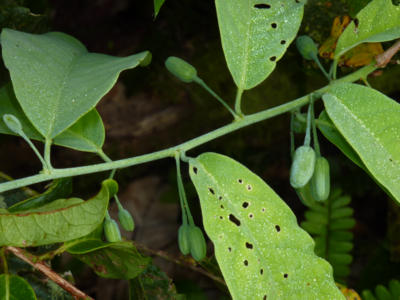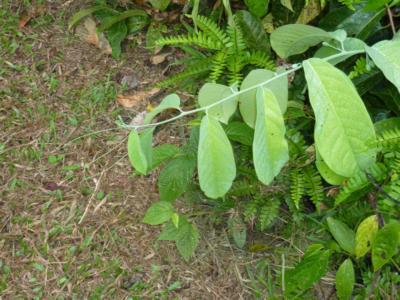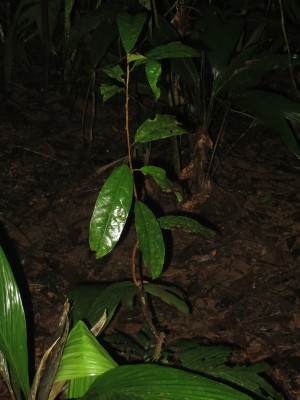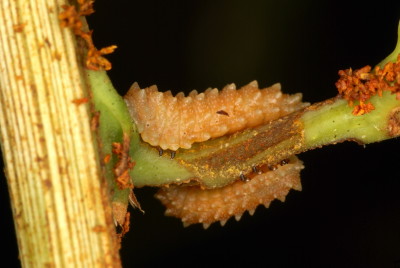Passiflora pittieri
P. pittieri is shrubby with large leaves found mainly in primary forest and tree fall clearings. Plants persist in the forest understory for years, perhaps protected by the highly cyanogenic leaves, and only occasionally produce a new shoot which is recognizably a Passiflora. Production of new shoots is episodic and can be infrequent, 3-4 shoots per year in some cases. The plants can be difficult to find; as of 2014 I knew the location of only 6 wild plants at La Selva. Nevertheless many more are undoubtably scattered through the forest. Range: Central America to Ecuador; in wet forest up to 800 meters elevation. In forest light gaps and understory.
P. pittieri belongs to subgenus Astrophaea, section Capreolata. Astrophaea are a diverse group of 57 Passiflora species found mainly in South America. A section Capreolata relative of P. pittieri is found in NW Ecuador, P. tina. The only other Costa Rican Astrophaea is P. tica from higher elevation in the mountains adjacent to La Selva. P. tica belongs to Astrophaea, section Arborea, and is a small tree, lacking tendrils entirely. P. tica is host plant for Heliconius eleuchia, a close relative of H. sapho.
P. pittieri foliage is strongly cyanogenic when crushed (0.5 to 28 μM HCN/g wet weight), especially including the old leaves. Even epiphyte-covered leaves over 2 years old were found to contain 0.5 μM/g. Spencer (1988) and Engler et al (2007) report finding simple monglycoside cyclopentyl sulfated cyanogens typical of subgenus Passiflora (Tetraphyllin B sulfate and Epitetraphyllin B sulfate) and complex diglycoside cyclopentyl cyanogens typical of subgenus Decaloba (Passibiflorin and Epipassibiflorin). The latter chemicals seem to play a significant role in interactions with herbivores, because larvae specialized to feed on P. pittieri (H. hewitsoni and Red Pedilia) will also feed to a limited extent on P. biflora. In addition, larvae of H. sara, which are host-specific on P. auriculata, feed and grow (poorly) when artificially placed on new growth of P. pittieri. Smiley and Wisdom (1985) also measured substantial amounts of tannins in P. pittieri. Charts illustrating P. pittieri cyanogenesis may be found in Appendix 2, charts A24, A25, A26, and A27.
Two measurements of cyanogenesis by crushed P. pittieri rootlets revealed surprisingly low amounts of HCN ( = 0.04 and < 0.022 μM/g, respectively). These surprising findings need further investigation.
H. cydno and the monophagous H. sapho lay their eggs on P. pittieri at La Selva, the former singly, on the tendril tips and the latter laying clutches of eggs on the shoot tips and young leaves. H. sapho is rare at La Selva; I have not seen a single batch of larvae on wild P. pittieri. Adult H. sapho mimic H. cydno and are hard to identify on the wing.
The Red Pedilia (Pedilia "Red") feeds only on this species of plant, maintaining large numbers of adults, eggs and larvae on the plant growing in the lab clearing at La Selva. It is rarely found on wild plants in the field, commensurate with the difficulty of finding the plants themselves; however, the distinctive feeding damage to the stems may occasionally be seen on wild plants. The generalist Monomacra violacea and one of the Parchicola species have been found on P. pittieri as well, although rarely.
Although P. pittieri is strongly cyanogenic, Pedilia "Red" has specialized behaviors that may help to avoid cyanide poisoning when feeding. These include eating tiny bites from one leaf layer only, eating the green stem epidermis, and eating leaf veins, all of which probably reduce HCN gas release. The distinctive feeding damage, including tiny bite marks, may be seen on stems and old leaves as well as new growth.


The petiolar glands on this species are small and flat aginst the base of the leaf. They attract ants when the leaves are soft and light green.
Red Pedilia larvae. Specialized to feed on pittieri only, these larvae can't grow on any of the other species of Passiflora at La Selva. However, they will feed a little on biflora, arbelaezii, and coriacea.

